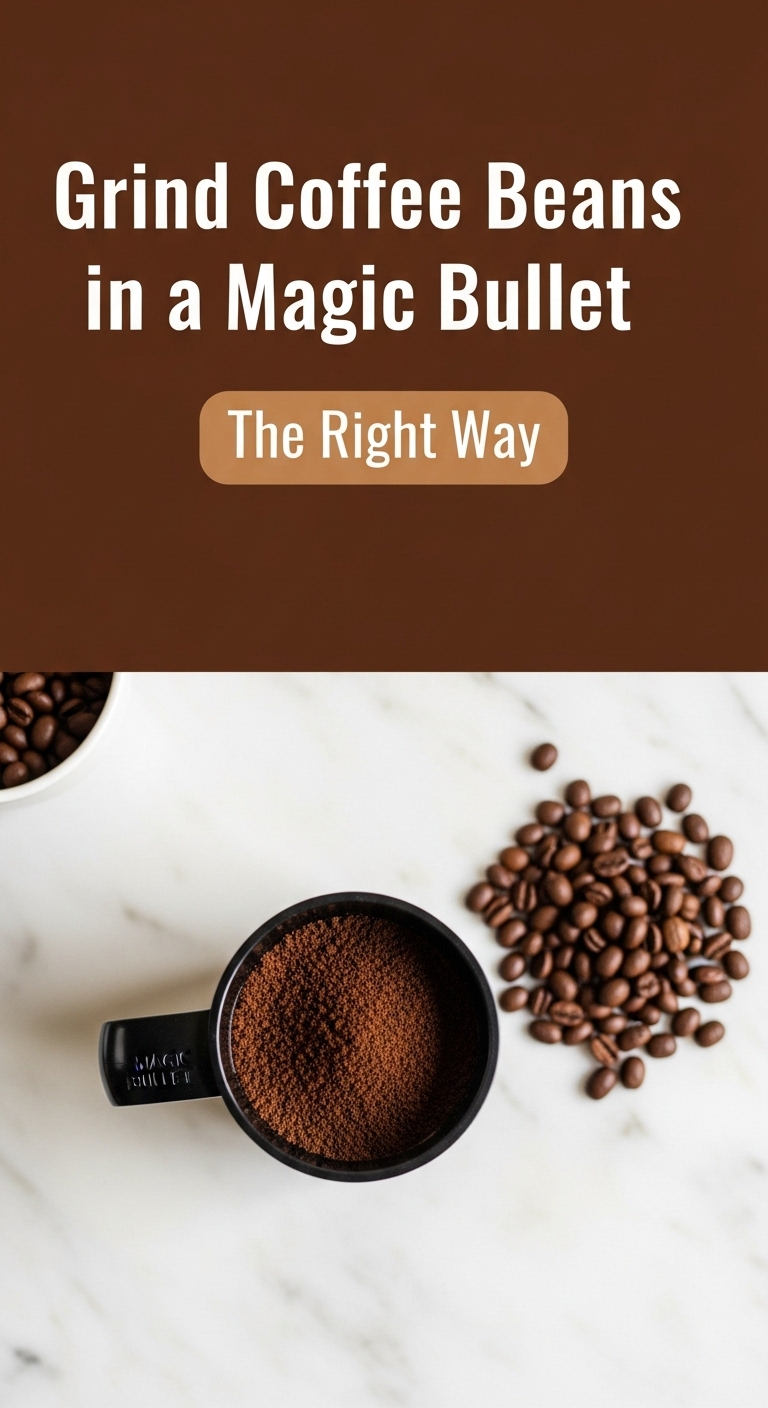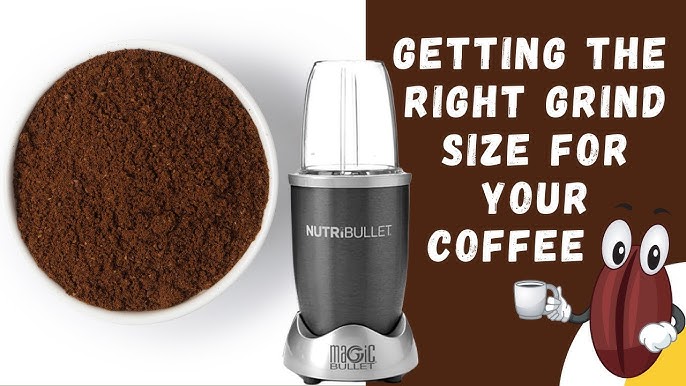As an Amazon Associate CoffeeXplore.com earns from qualifying purchases.
Grind Coffee Beans in a Magic Bullet: The Right Way
So you have a Magic Bullet and a bag of whole coffee beans, but no grinder. What do you do? You’re staring at your trusty personal blender, a whiz at making smoothies and sauces, and wondering if it can save your morning coffee ritual from the tragedy of pre-ground beans. The good news is, you’ve come to the right place for the answer.
Yes, you can grind coffee beans in a Magic Bullet, especially using the flat blade. It functions as a blade grinder, offering convenience for casual use, but it produces a less consistent grind than a dedicated burr grinder.
This comprehensive guide will show you exactly how to do it the right way. We’ll dive deep into the most critical step—choosing the correct blade—and provide a step-by-step process that prevents common mistakes like motor burnout and uneven grounds. Leveraging analysis of manufacturer guidelines and expert coffee advice, we will also give you an honest comparison against a real coffee grinder so you can decide if this method is truly right for you.
Can You Grind Coffee Beans in a Magic Bullet? The 2025 Guide
The short answer is a resounding yes. But the long answer is a bit more nuanced. The Magic Bullet is a multi-purpose kitchen tool, a master of chopping and blending. While not its primary function, its powerful motor and specialized blades can absolutely pulverize dry ingredients like coffee beans. This makes it a fantastic, cost-effective solution in a pinch or for those who aren’t ready to invest in a separate, dedicated machine. The key to success isn’t if you can do it, but how you do it.

This guide is built on a simple premise: using the right tools and techniques can turn your Magic Bullet from a last resort into a surprisingly effective coffee grinding tool. We’ll walk you through the entire process, ensuring you get the freshest possible coffee without damaging your appliance or your beans.
The #1 Most Important Choice: Using the Right Blade
Before you even think about adding beans to the cup, your first and most critical decision is selecting the correct blade. Getting this wrong is the fastest way to get a poor result. Your Magic Bullet likely came with two different types of blades, and only one is right for this job.
Based on manufacturer information from sources like NutriBullet and expert guides from NouveauRaw, the choice is clear. You must use the flat blade. The flat blade is specifically engineered for grinding and pulverizing hard, dry ingredients. Think of it as a milling tool. The cross blade, on the other hand, is designed to circulate and blend liquids for smoothies and sauces. Using it for coffee beans will result in them being erratically chopped and flung around the cup, creating a wildly inconsistent mess.
| Blade Type | Recommended Use | Why for Coffee? |
|---|---|---|
| Flat Blade | Grinding dry items (coffee, spices, nuts) | Creates a finer, more even pulverization. |
| Cross Blade | Blending liquids (smoothies, sauces) | Tends to chop unevenly and fling beans. |
Pro Tip: Think of the flat blade as a ‘mill’ and the cross blade as a ‘chopper’. For coffee, you want to mill the beans, not just chop them.
Step-by-Step: How to Grind Coffee Beans in a Magic Bullet
Ready? Let’s turn those beans into fresh grounds in under a minute. The secret to success with a Magic Bullet coffee grinder isn’t brute force; it’s technique. By following these simple steps, you’ll avoid the common pitfalls of overheating the motor and ending up with a mix of dust and whole beans. The key actions are to work in small batches and to pulse the machine instead of running it continuously.
Here is the exact process for a perfect grind every time:
- Prepare Your Equipment: Make sure the Magic Bullet cup and the flat blade are completely clean and dry. Any moisture will cause the coffee grounds to clump.
- Measure Your Beans: Add your whole coffee beans to the small blending cup. Critically, do not overfill it.
- Attach the Blade: Securely screw the flat blade attachment onto the cup until it’s snug.
- Grind with Pulses: Place the cup on the motor base and press down in short, 1-2 second bursts. This is the “pulsing” technique.
- Shake and Settle: Between every few pulses, remove the cup, give it a good shake, and tap it on the counter. This redistributes the beans for a more even grind.
- Check Your Grind: Continue pulsing until you reach your desired consistency.
- Settle the Grounds: Once finished, tap the cup firmly on the counter a few times before opening. This helps manage the static electricity that builds up during grinding.
Step 1: Measure Your Beans
One of the most common mistakes is overfilling the cup. While it’s tempting to grind a large batch at once, this is counterproductive. Do not fill the cup more than halfway with coffee beans to allow them to move freely for a more even grind. If the cup is too full, the beans at the bottom will turn to powder while the ones at the top remain untouched.
Remember, less is more here. You’ll get a better grind with two small batches than one overstuffed one. This also puts less strain on the motor, protecting your appliance in the long run.
Step 2: Use the “Pulsing” Technique
This is the single most important technique to master. Do not simply press down on the cup and hold it. This will overheat the motor and can actually “cook” the beans from the friction of the blade, introducing a burnt, bitter taste before you even start brewing.
Instead, you must pulse the Magic Bullet in short 1-2 second bursts instead of blending continuously. This prevents the motor from overheating and gives you control over the grind size.
- Prevents Overheating: Short bursts give the motor a moment to rest, preventing burnout.
- Controls Grind Size: The duration and number of pulses directly control how coarse or fine your grounds become.
- Improves Consistency: Pausing to shake the cup between pulses ensures all beans make contact with the blade.
For a coarse grind (French Press), use 8-10 short pulses. For a fine grind (drip/espresso-style), blend for 30-40 seconds, still using a pulsing motion to avoid overheating.
Step 3: Check for Consistency and Settle the Grounds
Don’t be surprised if the grounds are stuck to the side—that’s just static electricity at work. A simple tap is all you need. The high-speed action of the blade generates a significant amount of static, causing fine coffee particles to cling to the inside of the cup. This can also lead to some clumping.
After pulsing, tap the cup on the counter to settle the grounds and reduce static cling before opening. This small action makes the grounds easier to remove and gives you a clearer view of the grind consistency. If you see large, un-ground chunks, simply give it a few more pulses.
Magic Bullet vs. Burr Grinder: An Honest Comparison
So, you’ve successfully ground your coffee beans. But how does the result stack up against a dedicated coffee grinder? To manage expectations, it’s crucial to understand the fundamental difference between your Magic Bullet (a blade grinder) and a purpose-built burr grinder. The difference lies in how they process the beans, which directly impacts the flavor of your final cup.
A Magic Bullet acts as a blade grinder, chopping beans inconsistently, while a burr grinder crushes them uniformly. This makes burr grinders far superior for optimal coffee flavor. As sources like CoffeeGeek.TV and Ktchn Essentials explain, blade grinders shatter beans, creating a mix of fine powder (which over-extracts and adds bitterness) and large chunks (which under-extract and add sourness). Burr grinders crush beans between two abrasive surfaces to a uniform size, allowing for a balanced, even extraction.

Here’s a direct comparison:
| Feature | Magic Bullet (Blade Grinder) | Dedicated Burr Grinder |
|---|---|---|
| Mechanism | Chops/shatters beans with a spinning blade | Crushes beans between two abrasive surfaces |
| Grind Consistency | Inconsistent (mix of powder and chunks) | Highly consistent and uniform |
| Control | Manual control via pulse duration | Precise, repeatable grind settings |
| Flavor Impact | Can lead to uneven extraction (bitter/sour) | Optimal, balanced flavor extraction |
| Best For | Convenience, emergencies, casual drinkers | Coffee enthusiasts seeking best flavor |
Pros and Cons: Is Using a Magic Bullet Worth It?
Ultimately, deciding whether to grind coffee with a bullet blender comes down to a trade-off between convenience and quality. Based on analysis from numerous coffee resources like Roasty Coffee and CoffeeVoila, the verdict is clear: it works, but it has its limitations.
Which list resonates more with you? Your answer will tell you if this is the right method for your morning coffee.
Pros
- Convenience and Versatility: If you already own one, it’s ready to go. You don’t need another appliance taking up counter space.
- Cost-Effective: It saves you from buying a separate, specialized machine, making it a budget-friendly choice.
- Speed: You can go from whole beans to usable grounds in less than a minute.
- Freshness: Any freshly ground coffee, even from a Magic Bullet, is vastly superior in flavor and aroma to stale, pre-ground coffee.
Cons
- Inconsistent Grind: This is the biggest drawback. The mix of powder and chunks leads to poor flavor extraction.
- Risk of Motor Burnout: The small motor isn’t designed for the heavy-duty task of grinding hard coffee beans continuously. Pulsing is essential to prevent damage.
- Lack of Control: Achieving a specific grind size for different brew methods (like French Press vs. Drip) is a process of trial and error, not precision.
- Noise: Grinding hard beans in a small blender can be quite loud.
- Heat Generation: Even with pulsing, the high-speed blade can generate some heat, which can negatively affect the coffee’s flavor profile.
For those who prioritize flavor and want to get the most out of their specialty coffee beans, investing in a proper grinder is a logical next step. A quality burr grinder provides the consistency and control needed for a truly exceptional cup of coffee.
FAQs About Grinding Coffee in a Magic Bullet
Even with a step-by-step guide, you might still have a few questions. Here are direct answers to the most common queries about using a Magic Bullet for coffee.
Can you use a Ninja Bullet or Nutribullet to grind coffee beans?
Yes, the process for a Ninja Bullet or Nutribullet is nearly identical. For a Nutribullet, the specialized “milling blade” is the equivalent of the Magic Bullet’s flat blade and is highly recommended. These are all powerful personal blenders that function as blade grinders. Just be sure to use the correct blade for dry goods and always use the pulsing technique.
Will grinding coffee beans dull my Magic Bullet blade?
Yes, over time, grinding hard items like coffee beans can dull the blade, reducing its efficiency. Blades may eventually need replacement for best performance. While the stainless steel is durable, regular grinding of very hard substances will eventually wear down the sharp edge, meaning you may need to pulse for longer to achieve the same result.
How do I clean my Magic Bullet after grinding coffee?
Wash the cup and blade with soap and water immediately after use to prevent coffee oils from building up. Wipe the motor base with a damp cloth; never submerge it in water. Coffee beans contain oils that can become sticky and rancid, transferring unpleasant flavors to your next smoothie. A quick rinse right after use is the best way to keep your equipment clean.
Is the grind fine enough for espresso?
While you can achieve a fine, powder-like grind by blending for 30-40 seconds, it will likely be too inconsistent for a true espresso machine, which requires a very uniform grind to prevent channeling. Espresso extraction is highly sensitive to grind size. The mix of powder and slightly larger grounds from a Magic Bullet will cause water to flow through unevenly, resulting in a poor-tasting shot.
Final Verdict: When to Use Your Magic Bullet for Coffee
So, can you grind coffee beans in a Magic Bullet? Absolutely. Is it the best way? No. The Magic Bullet serves as a perfectly viable, convenient, and cost-effective coffee grinder for specific situations. It’s the ideal solution for the casual coffee drinker, for emergencies when your main grinder breaks, or for when you’re traveling.
However, if you are a coffee enthusiast who invests in high-quality beans and seeks the best possible flavor, the inconsistent grind produced by a blade grinder will always be a limiting factor. For you, an investment in a dedicated burr grinder will pay for itself in brew quality.
Here are the key takeaways:
- Always use the flat blade, which is designed for grinding dry ingredients.
- Use the “pulsing” technique in short, 1-2 second bursts to prevent overheating and control the grind.
- Accept the trade-off: You are trading professional-level grind consistency for countertop convenience and cost savings.
Now that you know the right way to do it, go ahead and give it a try for your next cup and see if the convenience works for you
Last update on 2025-12-15 / Affiliate links / Images from Amazon Product Advertising API

